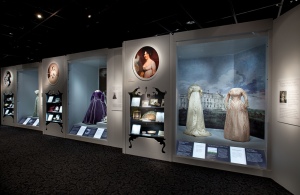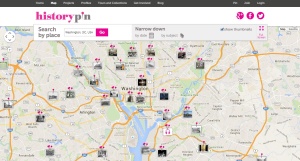Disembody: to divest of a body, of corporeal existence, or of reality
Featured image courtesy of the Smithsonian Institution
The topic for this post caught me by surprise. I will start by saying this: I am a long time museum enthusiast. I have built a career on working at and with them. I think that they are engaged in work of tremendous importance and cultural value. Yet it occurred to me this week that putting things in historical context is maybe not what they do best. I know – this sounds like blasphemy. Let me explain.
We have been engaged for much of this semester in a conversation about context and authenticity, and the implications for two concepts that are central to our practice when we do history on the web. There is a lively debate about context and authenticity in digital archives, for instance, and the loss of the archival bond – how a document relates to those around it – when materials are selectively digitized and organized online. Archival authenticity, some argue, is lost online. In “Big Data, Little Narration,” on the other hand, Dragan Espenschied demonstrates the power of the web to avoid creating “arbitrary relations,” touting web exhibits that do not introduce “order where there was no order.”
A week ago, while I acknowledged the relevance of Espenschied’s argument to the born-digital world – which also serves as a well-articulated case for the kind of randomized content that Museum Bots can produce – I did not immediately see how this argument might apply to the work historians do in museums, nor the exhibits they put on the web. In fact, in a blog about an exhibit I created on Omeka, I wrote that while my site “lacks serendipity or true archival content,” the platform did allow me to “arrange items across collections and institutions in new and meaningful ways.” That kind of content, I wrote, is valid. Its central to the work of a public historian.
I would not necessarily that I’ve changed my mind, only that considering the potential of mobile technology – and its ability to tap into our powerful sense of place – has made me think more about museums as a specific type of place. We have talked in detail about how mediated online experiences may not be as powerful – or authentic – as a physical experience. So, viewing a photograph of an object online will never replace the powerful feeling of being in the presence of the same artifact. But I started to wonder this week: how authentic is the museum experience?
Every object in a museum’s collection, as John Russick aptly points out, came from somewhere, it has a natural, original context. Yet museums selectively acquire, preserve, and display these objects, placing them next to other objects to which they likely have no real relationship. Curators impose the kind of order that Espenschied talks about, creating what I think is ultimately a false sense of context. Furthermore, because museums are trusted cultural authorities, the mere fact that an object is accessioned into the collection imbues it with meaning and value that is not inherent to the object. Amidst these layers of meaning, value, and –dare I say – artificiality, “authentic” might not be the right way to describe a museum. They disembody artifacts, divesting them, as the definition would suggest, of their reality.

Disembodiment in museum exhibits, epitomized. First Ladies exhibit, National Museum of American History.
I am not trying to say that this makes museums any less important, or that they should fundamentally change how they do business. As I was careful to point out at the beginning of this post, I think that museums have incredible potential and unquestionable value. My point is this: that mobile technology enables a digital experience that may come closer to “authentic” than museums are able.
Mobile technology allows us to come closer to this mystical (and, in truth, probably impossible to achieve – see Sam Wineburg, Historical Thinking and Other Unnatural Acts) concept. As Mark Tebeau points out in “Listening to the City,” an effective smartphone app has the power to transform “the landscape into a living museum,” reconnecting narrative and place. The Cleveland Historical project, Tebeau writes, has enabled a new, arguably better type of oral history that is “no longer disembodied from its geographical and historical contexts.” Sam Collins and Matthew Durington similarly see value in the potential of apps to enable experiences that go beyond tourism, “with its commodified and canned experiences.”
Mobile apps, in other words, allow for exploration, and for organic encounters with context. Objects in museums can never be returned to their original context, often because the place (and most certainly the time) in which they first existed is no longer accessible. This is precisely why we need museums – a dinosaur, for instance, cannot be experienced in context (and thank goodness for that). Yet museum professionals should be more invested in the sort of projects that forge stronger and more realistic contextual connections. Apps are one way to do just that. As John Russick notes, for instance, an app that located each object in a museum collection “could transform the current urban landscape into an historical excavation of the people and places” that define a city. I will simply say this in closing: museums pour a lot of time and resources into elaborately immersive and experiential exhibits. The truly immersive experience, however, may lie beyond their walls.


Thank you for your excellent post, Jen.
I find your argument that “mobile technology enables a digital experience that may come closer to “authentic” than museums are able” very intriguing.
While I agree that mobile technology does allow us to have a close connection to the past in terms of location, I am not sure if they are any more or less authentic than a museum’s.
You are careful to point out that the powerful feeling one gets from seeing an object in person cannot be replaced by mobile devices. And you merely suggest that objects are displayed in relation to other objects that make the meaning of the original object artificial. With that being said, do you think that visitors of a museum view objects in relation to the other objects or do you think visitors view the objects for exactly what they are/represent? For example, what if a visitor walks into the Star-Spangled Banner exhibit at NMAH, walks past all of the interpretive panels and tertiary objects, and goes straight to viewing the flag? Is this object less authentic for this visitor just because it happens to be curated with other objects and interpretation?
One other question I propose is just a side note: if you truly believe that museum are not very authentic, what do you think they can do to remedy the situation?
In any event, I found your argument to be very intriguing and well crafted.
LikeLike
Hi Anna,
Thanks for your comments and thoughtful questions. Here’s what I would say in response – I think that a museum visitor can have an extremely meaningful experience with artifacts like the Star Spangled Banner, and it is incredibly important that museums are collecting and preserving history. The experience of that moment is authentic because that’s something they cannot see anywhere else and it has personal meaning for them. Yet it is not authentic in the sense that it is experienced within its original context – its meaning has changed because it is in a museum. Does that make sense? I think the point I’m trying to make is that smartphone apps allow us to move things a bit closer to their original context, to see where they existed in space if not in time.
I’m not sure there is anything museums can do about authenticity, I think it’s just in their nature to collect and display things in a different sort of context that is just as important and meaningful, maybe just not entirely real. An example of a museum that maybe is more “authentic” in this sense is a house museum that still has original furniture and decor. In that case, the visitor sees these items in a more authentic context.
I hope this isn’t all just sounding like nonsense – as I pointed out I don’t mean to devalue the work museums do, I just think it’s important that they consider how mobile apps can enhance their collections.
LikeLike
You use John Russick’s point that “Everything came from somewhere,” and has an original context, but also say that museum curators “selectively acquire, preserve, and display these objects, placing them next to other objects to which they have no real relationship.” The only answer for me seems to be the complete opening of museum collections to the web, perhaps a democratization of the museum so to speak. In your words, “mobile technology enables a digital experience that may come closer to ‘authentic’ than museums are able.” Yes – this is why museums must adopt innovative, interactive technologies, including apps, to enhance even further their exhibits and collections for patrons. I also like your suggestion that, “the truly impressive experience, however, may lie beyond their walls.” In my post this week, I also touch on the experience one feels when seeing an artifact or object in person. Mobile applications, such as the Cleveland historical project Tabeu discusses, provide that experience of literally walking in someone else’s path and listening to that person’s story – reconnecting narrative and place. While at the same time, being able to see how the area has transformed throughout the years and bits of character that it still may retain. Everyone has a story, and perhaps only with the web can those full experiences into some conception of a global oral history.
LikeLike
Kit, thanks for your comment. I think you make an excellent point that “the complete opening of museum collections to the web” might be a way to avoid the artificial creation of context and meaning in museums. I think this goes back to the argument that Dragan Espenschied was making, that we should try not to create order where none exists.
LikeLike